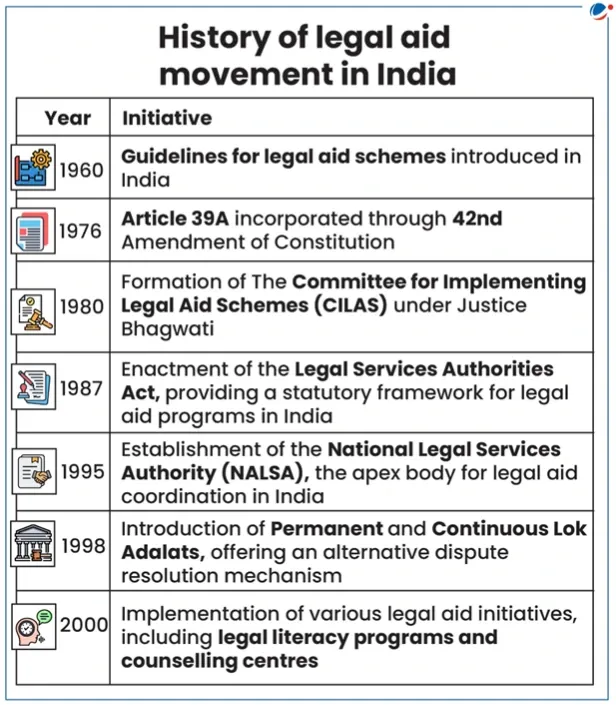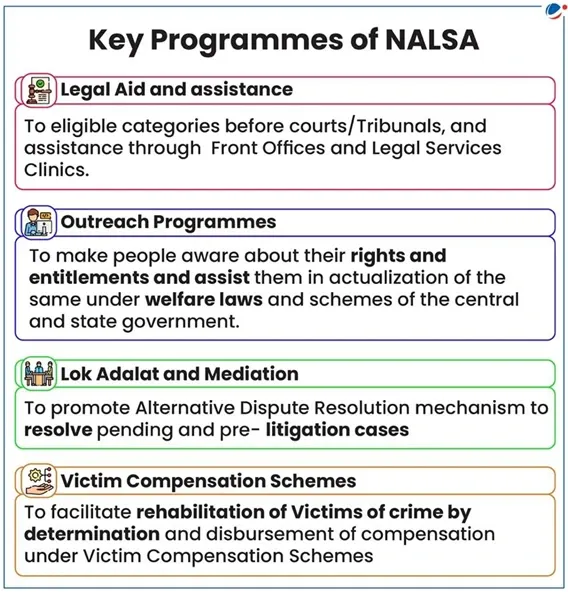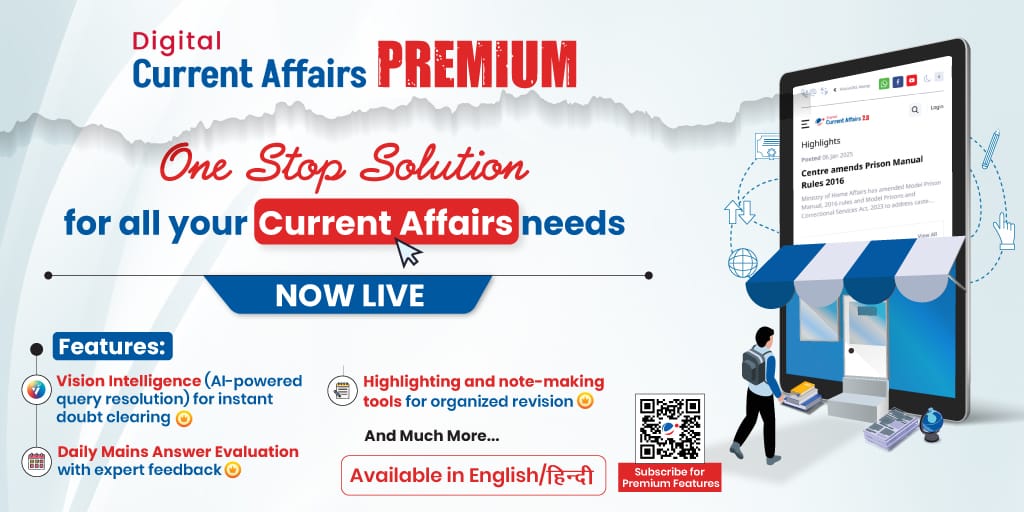The Prime Minister highlighted the significance of Free Legal Aid at the National Conference on "Strengthening Legal Aid Delivery Mechanisms" at the Supreme Court.
The National Conference on "Strengthening Legal Aid Delivery Mechanisms" at the Supreme Court of India marked a milestone in India's quest for accessible justice. As the National Legal Services Authority (NALSA) celebrates 30 years of service, this conference underscored the role of free legal aid in ensuring that justice remains within reach for every citizen, regardless of economic status.
The Prime Minister highlighted the government's commitment to enhancing the 'Ease of Justice' through mediation reforms and multilingual judgment translation, particularly for marginalized communities.
Mandate for Legal Aid
Free legal aid in India is a constitutional imperative rooted in Article 39A of the Constitution. Introduced through the 42nd Amendment Act of 1976, Article 39A mandates that the State shall ensure the operation of the legal system promotes justice on the basis of equal opportunity. It requires providing free legal aid through legislation or schemes to ensure no citizen is denied justice due to economic or other disabilities.

The constitutional guarantee recognizes that equality before law cannot exist if the poor and illiterate are unable to approach the courts, and their ignorance and poverty become impediments in obtaining justice. The phrase "economic or other disabilities" encompasses not merely poverty, but also illiteracy, lack of legal awareness, geographical remoteness, and unfamiliarity with legal procedures.
The Supreme Court has emphasized that free legal aid has been held to be a necessary adjunct of the rule of law, and that the right to free legal services is an essential ingredient of reasonable, fair and just procedure implicit in the guarantee of Article 21.
NALSA: Institutional Architecture of Justice Delivery
To operationalize Article 39A, Parliament enacted the Legal Services Authorities Act in 1987, which became enforceable on November 9, 1995. This date, now celebrated as National Legal Services Day, witnessed the birth of NALSA and a network of legal services institutions.
Four-Tier Hierarchical Structure
The Legal Services Authorities Act established a four-tier structure:
- National Legal Services Authority (NALSA): Headed by the Chief Justice of India as Patron-in-Chief, NALSA formulates policies and provides guidelines for the network.
- State Legal Services Authorities (SLSAs): Led by respective High Court Chief Justices, these authorities implement programs at the state level.
- District Legal Services Authorities (DLSAs): Chaired by District & Sessions Judges, DLSAs bring services to the district level.
- Taluka Legal Services Committees (TLSCs): Headed by senior Civil Judges, these committees ensure grassroots-level access.
This decentralized structure with centralized policy control ensures that free legal aid reaches India's remotest corners while maintaining uniform quality standards.

Who Qualifies for Free Legal Aid?
Section 12 of the Legal Services Authorities Act defines eligibility criteria, emphasizing socio-economic vulnerability. Automatic eligibility is granted to:
- Members of Scheduled Castes and Scheduled Tribes
- Victims of human trafficking and bonded labor
- Women and children
- Persons with disabilities and mentally ill individuals
- Industrial workers
- Persons in custody, including those in protective or juvenile homes
- Victims of mass disasters, ethnic violence, caste atrocities, and natural calamities
For others, the income threshold is Rs. 1,00,000 per year. However, for Supreme Court cases, this limit is raised to Rs. 5,00,000, acknowledging the higher costs of apex court litigation.
The free legal aid provided is comprehensive, covering court fees, lawyer services, certified copies, appeal preparation, and assistance in claiming welfare benefits.
Key Delivery Mechanisms Driving Impact
Lok Adalats: Revolutionizing Dispute Resolution
Lok Adalats, or People's Courts, represent NALSA's significant innovation in alternative dispute resolution. These forums settle disputes amicably, with awards that are final and binding with no provision for appeal, reducing court backlog while delivering swift justice.
The digital transformation through E-Lok Adalats has been remarkable. Between June 2020 and March 2023, E-Lok Adalats addressed 4.32 crore cases, including 3.36 crore pre-litigation matters, eliminating geographical barriers and making dispute resolution accessible.
Legal Aid Defence Counsel System (LADCS)
The LADCS ensures legal representation in criminal matters for eligible accused persons at all stages: pre-arrest, remand, trial, and appeal. With dedicated Chief, Deputy Chief, and Assistant Legal Aid Defense Counsel across districts, this system embodies the constitutional guarantee of Article 22(1) that every arrested person has the right to legal defense, protecting against misuse of authority.
Legal Literacy and Outreach
NALSA's preventive mandate extends beyond providing lawyers. Through door-to-door surveys, legal awareness programs, mobile vans, and legal aid clinics, authorities have reached over 11.6 crore persons. These initiatives educate marginalized communities about their rights and available remedies.
The Supreme Court conference outlined transformative initiatives aligned with the 'Ease of Justice' framework.
- Legislative Simplification: The government removed over 40,000 compliances, decriminalized 3,400 provisions through Jan Vishwas Act, and repealed 1,500 obsolete laws, reducing burden on the legal aid system.
- Technological Investment: eCourts Project Phase 3 budget increased to over Rs. 7,000 crore. Features like e-filing, electronic summons, virtual hearings, and video conferencing enhance justice delivery efficiency, supporting Article 39A's mandate.
- Breaking Language Barriers: Supreme Court translated over 80,000 judgments into 18 Indian languages. This democratizes legal knowledge when citizens understand judgments in their mother tongue, it promotes better compliance and reduces litigation.
- Reviving Mediation Traditions: Community Mediation Training Module launched aligns with the new Mediation Act, reviving India's tradition of resolving disputes through dialogue and consensus at the community level.
Challenges to Free Legal Aid in India
While NALSA's achievements are commendable, sustaining momentum requires addressing challenges:
Lack of Awareness and Legal Education: Despite over 80% eligibility, only 15 million Indians have used legal aid since 1995 (India Justice Report 2019).
Budgetary Constraints and Allocations: Since 2019, the national per capita spending on legal aid has doubled from roughly ₹3 to ₹7.
Role of Lawyers and Compensation: Lawyers refrain from pro bono work due to fee caps; they receive nominal honorarium ranging from ₹1,500 to ₹7,500.
Challenges Faced by Lok Adalats: Limited powers and procedural constraints, inability to compel parties to appear causing delays, and insufficient infrastructure and resources.
Under-utilisation of Para-Legal Volunteers (PLVs): Para-legal volunteers remain inadequately integrated into the legal aid delivery system.
Shortage of Staff and Unfilled Vacancies: As of December 2022, NALSA operated with only 20 staff members out of its sanctioned 34 positions.
Conclusion
As NALSA completes 30 years, the journey from constitutional promise to ground-level delivery demonstrates India's commitment to justice for all. The integration of free legal aid with technological innovation, linguistic accessibility, and legislative rationalization creates an ecosystem where justice is not a privilege but a fundamental right.
The National Conference's emphasis on strengthening delivery mechanisms signals that the next phase will focus on quality, inclusivity, and technological empowerment. The constitutional mandate of Article 39A is no longer just a directive principle but a living reality, touching millions of lives and ensuring that the promise of justice reaches every citizen, regardless of their economic circumstances.

Master Digital Age Governance & Technology Trends with VisionIAS Comprehensive Current Affairs →
FAQs on Free Legal Aid and NALSA
1. What is the full form of NALSA?
Ans. National Legal Services Authority.
2. Which constitutional article mandates free legal aid in India?
Ans. Article 39A of the Constitution.
3. When was NALSA established and made operational?
Ans. November 9, 1995.
4. Who is eligible for free legal aid in India?
Ans. SC/ST members, women, children, disabled persons, trafficking victims, and those earning below Rs. 1 lakh annually.
5. What are Lok Adalats in India?
Ans. People's Courts that settle disputes amicably with final and binding awards.